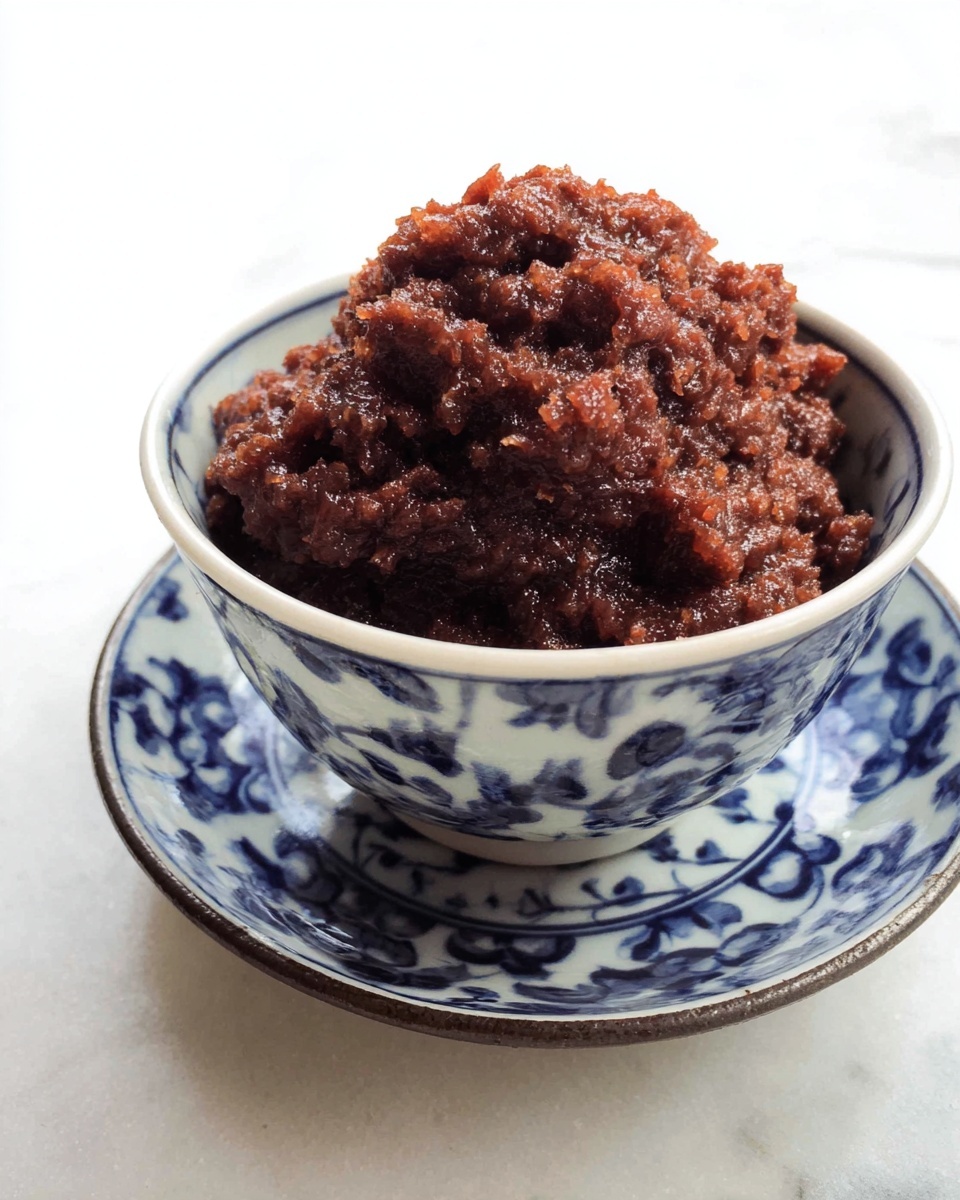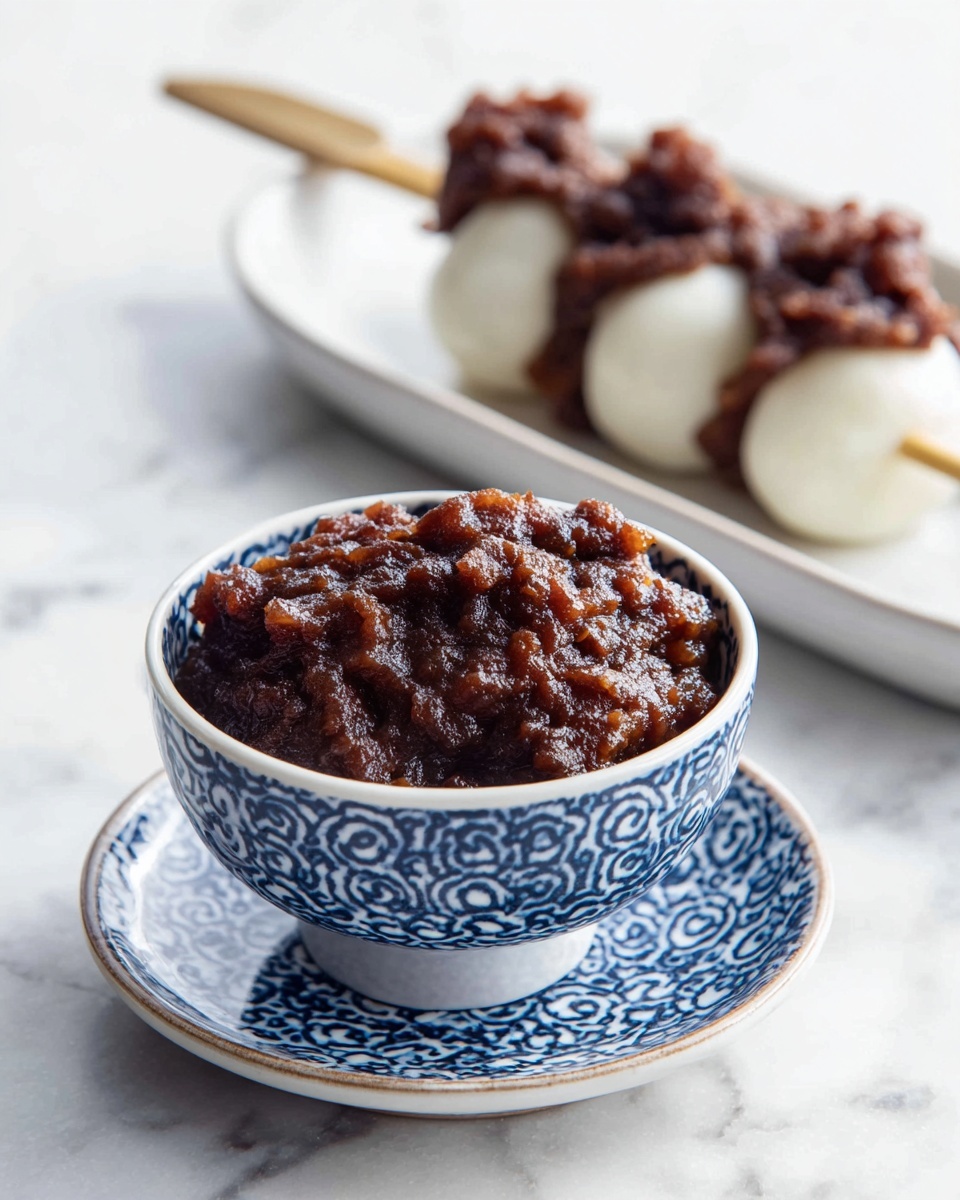Sweet Japanese Red Bean Paste (Anko) Recipe
If you’ve ever tried Japanese desserts, you might have fallen in love with that sweet, smooth, and subtly earthy flavor of red bean paste. Making your own at home, with this Sweet Japanese Red Bean Paste (Anko) Recipe, is not only satisfying but also gives you a versatile ingredient that elevates so many treats—from mochi to dorayaki. What’s special about this anko is its perfect balance of sweetness and texture, which you control yourself, unlike many store-bought versions.
I remember the first time I made anko—it felt like unlocking a little cultural secret in my kitchen! Plus, it’s surprisingly simple with just a few ingredients and some patience. If you’re looking to explore Japanese cooking or just want a wholesome homemade sweet spread, this Sweet Japanese Red Bean Paste (Anko) Recipe is a fantastic place to start.
Ingredients You’ll Need
The magic behind this Sweet Japanese Red Bean Paste (Anko) Recipe lies in using quality azuki beans and just enough sugar to bring out their natural sweetness. These ingredients work harmoniously to create that authentic flavor and creamy texture we all love.
- Azuki beans: The star of the recipe—look for small, bright red beans which cook evenly and have a mild, nutty sweetness.
- Sugar: Granulated white sugar is classic here; it sweetens without overpowering the beans’ flavor. You can adjust the amount to your taste.
- Salt: Just a pinch to balance the sweetness and enhance the deep flavor of the beans.
- Boiling water: Used for rinsing the beans and starting the cooking process to remove any bitterness.
- Water: Needed for soaking and simmering the beans until they become tender.
Variations
I love adapting this Sweet Japanese Red Bean Paste (Anko) Recipe depending on how I plan to use it. Feel free to tailor the sweetness or texture to fit your dessert dreams—that’s the fun part!
- Chunky Anko: I’ve made this by mashing the beans less for a rustic texture that pairs wonderfully with ice cream.
- Shiro Anko (White Bean Paste): For a different twist, try substituting azuki beans with white kidney beans, which yield a milder taste and pale color.
- Reduced Sugar: When I want a healthier version, I cut back the sugar and let the beans’ natural flavor shine through.
- Matcha Anko: Mixing a little matcha powder into the paste creates a tea-infused delight, perfect for special treats.
How to Make Sweet Japanese Red Bean Paste (Anko) Recipe
Step 1: Soak the Azuki Beans Overnight
Start by rinsing 1 cup of azuki beans under cold water, then soak them overnight in plenty of water (about 5 cups). This step helps soften the beans and reduces cooking time. Trust me, it’s worth the wait for that perfect tender texture!
Step 2: Parboil to Remove Bitterness
After soaking, drain the beans and place them in a pot with fresh boiling water, just enough to cover them by about 1/2 inch. Bring to a boil for 5 minutes, then drain again. This helps remove any bitter compounds from the beans, giving your paste a clean, mild taste.
Step 3: Simmer Until Soft
Return the beans to the pot and add roughly 5 cups of fresh water. Simmer gently over low heat, partially covered, for about 1 to 1.5 hours. Add water as needed to keep the beans submerged. You’ll know they’re ready when they’re very tender, almost falling apart—you can test by mashing a bean between your fingers.
Step 4: Sweeten and Cook Down
Once the beans are soft, drain most of the cooking liquid but keep a little to help with texture. Return the beans to the pot, add 1 cup of sugar and a pinch of salt, and cook over low heat. Stir constantly—this prevents burning and helps dissolve the sugar evenly. Continue cooking until the mixture thickens to your preferred consistency, typically about 10-15 minutes. Remember, it will thicken more as it cools.
Step 5: Mash or Blend to Desired Texture
I like using a potato masher for a chunky paste, but if you prefer smoother, a quick blitz with a food processor works wonders. Just don’t overprocess unless you want a silky anko. Taste and adjust sweetness if needed, then let it cool.
How to Serve Sweet Japanese Red Bean Paste (Anko) Recipe

Garnishes
I usually garnish anko with a sprinkle of toasted sesame seeds or a small dusting of kinako (roasted soybean flour) for an extra layer of nutty flavor. Sometimes a touch of fresh mint brightens it up beautifully when serving as a spread on toast or pancakes.
Side Dishes
Anko is a perfect partner for mochi, ice cream, or Japanese steamed buns. I also love adding a dollop to plain yogurt or using it as a filling for dorayaki pancakes. When I make a tea ceremony snack platter, anko-covered wagashi is always a standout.
Creative Ways to Present
For a special occasion, I like to shape the anko into small balls and coat them with shredded coconut or matcha powder. Another fun idea is layering anko with whipped cream and fresh fruit in a parfait glass—simple but elegant!
Make Ahead and Storage
Storing Leftovers
After cooling, I transfer leftover anko to an airtight container and keep it in the refrigerator. It stays fresh for about a week and actually tastes better the next day as the flavors meld.
Freezing
Freezing anko works great, too. I portion it into small containers or freezer bags, squeezing out air to avoid freezer burn. When you’re ready, just thaw it in the fridge overnight—it retains its texture well with minimal loss of flavor.
Reheating
To reheat, gently warm anko in a small saucepan over low heat, stirring often so it doesn’t scorch. You can also microwave it in short bursts, stirring in between. Adding a little water helps loosen the paste if it’s too thick after refrigeration.
FAQs
-
Can I use canned red beans instead of dried azuki beans?
While canned red beans can technically be used, they are often too soft and watery for making authentic anko. The drying and soaking process of azuki beans gives you better control over texture and flavor. So, I recommend using dried azuki beans whenever possible.
-
How sweet should my Sweet Japanese Red Bean Paste (Anko) be?
Sweetness depends on personal taste and the dish you’re pairing it with, but traditionally anko is mildly sweet—enough to delight without overpowering. Start with the recommended sugar amount, then adjust after tasting once it thickens.
-
What’s the difference between chunky and smooth anko?
Chunky anko retains some whole or partially mashed beans, offering texture and heartiness, perfect for certain snacks. Smooth anko is mashed or blended until creamy, often used in finer desserts. You can choose or make both depending on your preference.
Final Thoughts
This Sweet Japanese Red Bean Paste (Anko) Recipe is like having a little piece of Japan right in your kitchen. Once you master it, you’ll find endless delicious ways to enjoy it, and I promise it’s easier than it looks. Give it a try—you might just start hiding jars of this homemade goodness in your fridge, like I do!
Print
Sweet Japanese Red Bean Paste (Anko) Recipe
- Prep Time: 10 minutes
- Cook Time: 1 hour 30 minutes
- Total Time: 1 hour 40 minutes
- Yield: About 2 cups of sweet red bean paste 1x
- Category: Dessert
- Method: Stovetop
- Cuisine: Japanese
- Diet: Vegan
Description
Anko is a traditional Japanese sweet red bean paste made from azuki beans and sugar, commonly used as a filling in various Japanese desserts such as mochi, dorayaki, and taiyaki. This recipe walks you through the process of simmering azuki beans until soft and sweetening them with sugar and a pinch of salt to create a smooth, rich paste that balances sweetness with a subtle earthy flavor.
Ingredients
Ingredients
- 1 cup azuki beans (200g / 7oz)
- 1 cup sugar (200g / 7oz)
- 1 pinch salt
- Boiling water enough to cover the beans about 1 cm / 1/2 inch above the top
- 5 cups water
Instructions
- Rinse the Azuki Beans: Thoroughly rinse 1 cup of azuki beans under cold water to remove any impurities or dust.
- Initial Boil and Drain: Place the beans in a pot and cover them with boiling water so that the water level is about 1 cm (1/2 inch) above the beans. Bring to a boil and cook for 5 minutes. Drain the water to remove bitterness.
- Simmer the Beans: Return the beans to the pot and add 5 cups of fresh water. Bring to a boil again, then reduce heat to low and simmer gently for about 1 to 1.5 hours until the beans become soft and easily mashable. Stir occasionally and add more water if necessary to keep beans submerged.
- Add Sugar and Salt: Once the beans are soft, add 1 cup (200g) of sugar and a pinch of salt to the pot. Stir continuously and cook over low heat for an additional 10 to 15 minutes, allowing the sugar to dissolve completely and thicken the mixture.
- Mash the Beans: Using a wooden spoon or potato masher, gently mash the beans to your desired consistency. For smooth anko, mash thoroughly; for chunky anko, leave some beans whole.
- Cool and Store: Remove the paste from heat and let it cool to room temperature. Store in an airtight container and refrigerate. Use within one week for best flavor and freshness.
Notes
- You can adjust the sugar quantity depending on your preferred sweetness.
- Add water during simmering if the beans begin to stick to the bottom of the pot.
- For a smoother texture, pass the cooked beans through a sieve or blend lightly.
- Anko can be frozen for up to one month. Thaw in the refrigerator before use.
- Use red bean paste as a filling in desserts like mochi, dorayaki, and anpan.
Keywords: Anko, Japanese sweet red bean paste, azuki beans recipe, traditional Japanese dessert filling, sweet red bean paste recipe







